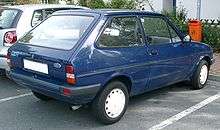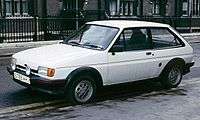Ford Fiesta (second generation)
| Ford Fiesta Mk2 | |
|---|---|
 | |
| Overview | |
| Manufacturer | Ford Europe |
| Production | 1983–1989 |
| Assembly |
Almussafes, Spain (Ford Valencia) Dagenham, United Kingdom (Ford Dagenham) Cologne, Germany (CB&A) Saarlouis, Germany (SB&A) |
| Body and chassis | |
| Class | Supermini (B) |
| Body style |
3-door hatchback 3-door panel van |
| Powertrain | |
| Engine |
957 cc (58.4 cu in) Valencia I4 1,117 cc (68.2 cu in) Valencia I4 1,298 cc (79.2 cu in) Valencia I4 1,298 cc (79.2 cu in) CVH I4 1,392 cc (84.9 cu in) CVH I4 1,597 cc (97.5 cu in) CVH I4 1,608 cc (98.1 cu in) LT Diesel I4 |
| Transmission |
4-speed BC4 manual 5-speed BC5 manual CVT automatic |
| Dimensions | |
| Wheelbase | 2,286 mm (90.0 in) |
| Length | 3,565 mm (140.4 in) |
| Width | 1,567 mm (61.7 in) |
| Height | 1,360 mm (54 in) |
| Chronology | |
| Predecessor | Ford Fiesta (first generation) 1976-1983 |
| Successor | Ford Fiesta (third generation) 1989-1997 |
The Ford Fiesta Mk2 was the second generation of the Ford Fiesta supermini built by Ford Europe. Originally introduced in 1983, it was a mild facelift of the original car, and it was available in 3-door hatchback and panel van styles. It was replaced by the heavily updated Fiesta Mk3 for 1989.
History
Initial development
The Ford Fiesta Mk2 appeared towards the end of summer 1983, with a revised front end and interior; the most notable change involved the new wraparound headlights.[1] At launch, the Mk2 Fiesta was only available with the familiar 957cc and 1117cc Kent Crossflow-based "Valencia" engine options.[1] The more bulbous bonnet line of the Mk2 was created largely due to the need to package the taller Ford CVH engine, a 1.3 L version of which followed in 1984, and this model also featured a 5-speed manual transmission for the first time.[1]
Two other versions of the Mk2 Fiesta appeared in 1984; there was an updated XR2 model with a 1.6–L version of the CVH engine: the second generation Fiesta XR2 model came with a larger bodykit. It also featured a 96 bhp (72 kW) 1.6 L CVH engine as previously seen in the Ford Escort XR3, and a five-speed manual gearbox.[2]
There was also a new 1.6 L diesel engined version of the Fiesta.[1] Diesel power units in this market segment were still unusual, and commentators found that the impressive fuel economy of the diesel powered Fiesta came at the expense of a power unit that was noisy and rough.[3] Even in West Germany, a market traditionally receptive to diesel powered passenger cars, the petrol/gasoline powered Fiesta was still outselling the diesel version by more than four to one in 1988.[4]
1986 upgrade
The XR2's engine was replaced by a lean-burn variant in November 1986 which featured a revised cylinder head and carburettor; this reduced emissions, but resulted in a small drop in power (although Ford still claimed the same maximum power output).[5] At this point the manufacturer also took the opportunity to offer the 5-speed manual transmission, already standard on the 1.3 L model, as an option with the upgraded 1.1 L car.[6]
The 1.3–L CVH was replaced by a 1.4–L lean burn version of the same power unit for 1986, whilst the other engines were modified in order to use unleaded petrol.[1] In February 1986 all models received the 40 litre fuel tank, previously reserved for the XR2 model, increasing fuel capacity and range by 17%.[7]
Fiesta automatic
In May 1987, Ford added the new CTX, incorporating continuously variable transmission, to the range, although it was only offered with the 1.1 engine,[1] and relatively few of these Fiesta CTXs were produced.[8]
Commercial
The Mk2 Fiesta, facing competition from the Vauxhall Nova and Austin Metro, was one of the UK's top superminis. In its best-ever year, 1987, over 150,000 Fiesta models were sold in the UK,[9] though it finished second in the sales charts to the Ford Escort.
In West Germany, then Europe's largest national car market, the Fiesta managed to outsell the Volkswagen Polo in 1984, 1985 and again in 1989, while the Polo narrowly outsold the Fiesta each year between 1986 and 1988.[10][11] Throughout this period, West German sales of the Opel Corsa trailed those of both the Fiesta and the Polo.[12]
By April 1989, when a new generation of Fiesta was launched, combined production and sales of the first two generations of Fiesta, produced between 1976 and 1989, had exceeded 4.5 million units.[13]
Specifications
| Model | Displacement | Type code | Power | Top Speed | 0–60 mph (0–97 km/h) (s) | Years |
|---|---|---|---|---|---|---|
| 950[14] | 957 cc (58.40 cu in) | Valencia | 44 hp (45 PS; 33 kW) | 85 mph (137 km/h) | 18.7 | 1983–1986 |
| 950[15] | 957 cc (58.40 cu in) | Valencia | 44 hp (45 PS; 33 kW) | 85 mph (137 km/h) | 19.5 | 1986–1989 |
| 1.1[16] | 1,117 cc (68.16 cu in) | Valencia | 50 hp (51 PS; 37 kW) | 88 mph (142 km/h) | 16.0 | 1983–1986 |
| 1.1[17] | 1,117 cc (68.16 cu in) | Valencia | 50 hp (51 PS; 37 kW) | 90 mph (145 km/h) | 16.3 | 1986–1989 |
| 1.1 cat[18] | 1,117 cc (68.16 cu in) | Valencia | 48 hp (49 PS; 36 kW) | 88 mph (142 km/h) | 17.1 | 1986–1989 |
| 1.3[19] | 1,296 cc (79.09 cu in) | CVH | 68 hp (69 PS; 51 kW) | 101 mph (163 km/h) | 11.5 | 1984–1986 |
| 1.4[20] | 1,392 cc (84.95 cu in) | CVH | 74 hp (75 PS; 55 kW) | 103 mph (166 km/h) | 11.4 | 1986–1989 |
| 1.4 cat[21] | 1,392 cc (84.95 cu in) | CVH | 69 hp (70 PS; 51 kW) | 100 mph (161 km/h) | 12.3 | 1986–1987 |
| 1.4 cat[22] | 1,392 cc (84.95 cu in) | CVH | 70 hp (71 PS; 52 kW) | 101 mph (163 km/h) | 12.3 | 1987–1989 |
| 1.6 D[23][24] | 1,608 cc (98.13 cu in) | LT | 53 hp (54 PS; 40 kW) | 92 mph (148 km/h) | 16.3 | 1984–1989 |
| 1.6 XR2[25] | 1,597 cc (97.45 cu in) | CVH | 95 hp (96 PS; 71 kW) | 112 mph (180 km/h) | 9.4 | 1984–1986 |
| 1.6 XR2[26] | 1,597 cc (97.45 cu in) | CVH | 94 hp (95 PS; 70 kW) | 109 mph (175 km/h) | 9.7 | 1986–1989 |
| 1.6 XR2 (Sweden)[27] | 1,597 cc (97.45 cu in) | CVH | 78 hp (79 PS; 58 kW) | 1986–1989 |
-

Ford Fiesta Mk2 rear
-

1984 Ford Fiesta XR2
-

Ford Fiesta C 1.1 Mk2
References
Oswald, Werner (2003). Deutsche Autos 1945-1990, Band (vol) 3 (in German). Motorbuch Verlag, Stuttgart. ISBN 3-613-02116-1.
- 1 2 3 4 5 6 "History of the Fiesta 1983 to 1989". TheFiesta.com. Retrieved 30 January 2015.
- ↑ "Fiesta XR2 MkII". Auto Express. 17 November 2008. Retrieved 30 January 2015.
- ↑ Oswald, pp 444 & 447 "... recht läuft und unkultiviert lauft ..."
- ↑ Oswald, p 446
- ↑ "The History of the Mk2 XR2". Project Bobcat. Retrieved 30 January 2015.
- ↑ Oswald, pp 444 & 447
- ↑ Oswald, pp 444, 447 & 449
- ↑ Oswald, p 444
- ↑ "Still going strong, Ford's youthful spirited Fiesta is celebrating its 30th birthday". Media.Ford.com. 25 August 2006.
- ↑ Oswald, p 446
- ↑ Note that the sales data for the Volkswagen Polo are aggregated here with those of the Volkswagen Derby which was a Polo with a boot/trunk. Opel Corsa sales quoted here also include the "booted" version of the car. There was never a second generation Fiesta with a boot/trunk
- ↑ Oswald, p 446
- ↑ Oswald, p 444
- ↑ "1983 Ford Fiesta 1.0 (Popular) (model since September 1983 for Europe ) specifications & performance data review". automobile-catalog.com. Retrieved 31 January 2015.
- ↑ "1986 Ford Fiesta 1.0 Festival (model since mid-year 1986 for Europe ) specifications & performance data review". automobile-catalog.com. Retrieved 31 January 2015.
- ↑ "1983 Ford Fiesta 1.1 L (model since September 1983 for Europe ) specifications & performance data review". automobile-catalog.com. Retrieved 31 January 2015.
- ↑ "1986 Ford Fiesta 1.1 Popular Plus (model since mid-year 1986 for Europe ) specifications & performance data review". automobile-catalog.com. Retrieved 31 January 2015.
- ↑ "1986 Ford Fiesta 1.1 Festival cat (model since mid-year 1986 for Europe ) specifications & performance data review". automobile-catalog.com. Retrieved 31 January 2015.
- ↑ "1984 Ford Fiesta 1.3 Ghia (for Europe ) specifications & performance data review". automobile-catalog.com. Retrieved 31 January 2015.
- ↑ "1986 Ford Fiesta 1.4 L (model since mid-year 1986 for Europe ) specifications & performance data review". automobile-catalog.com. Retrieved 31 January 2015.
- ↑ "1986 Ford Fiesta 1.4 C cat (model since mid-year 1986 for Europe ) specifications & performance data review". automobile-catalog.com. Retrieved 31 January 2015.
- ↑ "1987 Ford Fiesta 1.4i Festival cat (model since mid-year 1987 for Europe ) specifications & performance data review". automobile-catalog.com. Retrieved 31 January 2015.
- ↑ "1984 Ford Fiesta 1.6 D (for Europe ) specifications & performance data review". automobile-catalog.com. Retrieved 31 January 2015.
- ↑ "1986 Ford Fiesta 1.6 D C (model since mid-year 1986 for Europe ) specifications & performance data review". automobile-catalog.com. Retrieved 31 January 2015.
- ↑ "1984 Ford Fiesta XR-2 (model since February 1984 for Europe ) specifications & performance data review". automobile-catalog.com. Retrieved 31 January 2015.
- ↑ "1986 Ford Fiesta XR-2 (model since mid-year 1984 for Europe ) specifications & performance data review". automobile-catalog.com. Retrieved 31 January 2015.
- ↑ "1986 Ford Fiesta XR-2 (model since mid-year 1986 for Europe Sweden ) specifications & performance data review". automobile-catalog.com. Retrieved 31 January 2015.